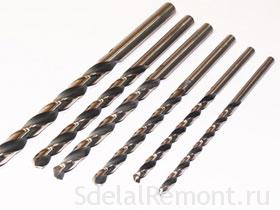
drilling tools
Holes are cut by drilling. For this purpose, the drill used as helices, gimlet, electric and hand drills, etc.. d. See useful article how to choose a drill for metal, concrete, wood right. We have drills are divided into cutting and cylindrical working part, shank, placed in the spindle (torsion shaft, having a device for fastening the drill bit, etc.. P.) the machine, and foot. To chip in the process of flying away in the direction of, in the cylindrical part of the tool is performed with two helical grooves ribbons at the edges. Ribbons are designed to reduce the friction of the drill holes on the edge.
The cutting part of the drill made in the form of a cone. It there are three edge: one transverse and two cutting. Depending on the metal, of construction of the part, sharpening angle drill operate within the 110-150 °. drill shank may have a conical or cylindrical shape. The shank cylindrical shape fixed jaw chuck in the spindle. Shank, having a conical shape, held in the spindle due to the friction between the cone and the shank of the transition cone sleeve. Claw drill is designed for abutment against the extraction of the drill from the slot or cartridge.
When the drill bit, spinning, removes chips with a metal surface and, gradually delving into the details, moving along the axis of rotation. If the corners of the drill cutting edge quickly become dull, a measure of, that the rotation speed is too high, and it is necessary to reduce. It can be done only after, the drive will shut down completely.
We need to work with an electric drill in rubber gloves or standing during the drilling of one foot on the rubber mat. Besides, you need to constantly monitor the status of an electric wire. Upon completion of drilling operations should be carefully collect the chips with a broom and throw.
coring tool
The tool is intended for finishing grooves conical or cylindrical, and chamfering drill holes under the screw heads, screws and rivets. The countersink may be conical and cylindrical. Cylindrical countersink consists of shank, working part with 4-8 teeth and guide pin, which is lowered into the drilled hole, whereby the bore axis and aligned recesses, obtained by countersinking. We also have a tapered countersink shank and a working portion. In most cases, used with a cone angle countersinks 60, 90 and 120 °.
countersink tool
Countersink is designed for finishing obtained by different methods (in stamping, drilling, forging or casting) holes. Countersink looks like a drill. But unlike having 2 Drill cutting edge, from their countersink 3 or 4. Shank countersink is clamped in the chuck. If the hole is drilled using a drill, and have to sweat Vertical, the drill diameter must be smaller than the diameter of the finished hole.
punch tool
Crust breaker is used to make holes of different diameters.












